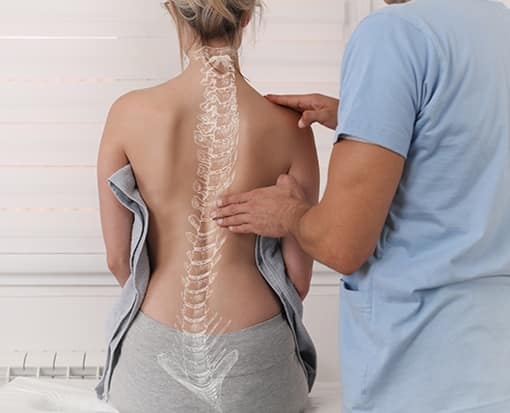EMG and NCS Testing in Buffalo
Identifying the Root Cause of Nerve Pain
EMG and NCS testing stands for electromyography and nerve conduction studies. We recommend this test for patients who are suffering with pain that we believe might be related to the muscles or the nerves. These studies evaluate traumatic injuries, muscle diseases, nerve root disorders, peripheral nerve problems, and nerve conditions of the spine, feet, and hands. In addition to back and neck pain, patients with spinal issues often experience unexplained symptoms, numbness, cramps, and/or weakness. The test helps us determine location, severity, and whether the damaged nerves may respond to treatment.
The two main parts of this test are a needle exam for muscle testing and a nerve conduction study. During the NCS exam, we apply tiny electrical impulses to the nerve and measure the nerve’s response. The patient tends to feel a minor tingling sensation at this time. During EMG, thin needle electrodes are placed in the muscles. We are completely sterile and safe throughout this process, using a new and clean needle for each patient and testing only the essential areas. This test normally takes between 45 and 60 minutes. It is important to let us know if you are taking a blood-thinning medication or have any kind of blood disorder before undergoing one of these tests.
EMG and NCV testing helps us diagnose and create treatment plans for the following problems:
Cervical and Lumbar radiculopathy
Cervical radiculopathy is quite literally a pain in the neck and arm. Lumbar radiculopathy causes back pain with leg symptoms. When a nerve root in the spine becomes inflamed or damaged, the neurological function is impaired. This pain usually begins in the neck or back and moves down to the arm or leg. The EMG test identifies the specific nerve roots involved. We prescribe a combination of therapies for this condition, including physical therapy, immobilization, manipulation, or referral for a surgical consult should the condition not respond to conservative care.
Peripheral nerve damage
This condition is a result of damage to the nerves in the arms and legs. It usually causes symptoms like pain, numbness, or weakness in the limbs including the hands and feet. This is an important condition to identify using NCS because eliminating the underlying cause can prevent progressive and permanent nerve damage.
Nerve damage in arm
Patients who have nerve damage in the arm experience pain, numbness, weakness, and/or losses of sensation that can range from the upper arm to the forearm and hand. It can be difficult for a patient to know if they have nerve damage in the arm unless they take an exam like the EMG and NCS test. Identifying what nerves are involved allow the proper treatment plans to be made to correct the problem.
Ulnar nerve damage
The ulnar nerve is often referred to as “the funny bone”. It is actually a nerve that travels from the lower neck down the arm to the medial elbow to the wrist, hand, and last two fingers. Ulnar nerve damage, or ulnar neuropathy, happens when this particular nerve is damaged. Patients with the condition tend to experience “pins and needles” sensations in the elbow, forearm, and ring and pinky fingers. Physical therapy, manipulation, and soft tissue mobilization has been shown to help reduce these symptoms and bring relief to patients.
Carpal tunnel syndrome
This condition is also referred to as Median neuropathy. It can result from repetitive motion as well as from a traumatic injury. This occurs when abnormal pressure is placed on the median nerve, causing symptoms in the hand – especially the palm and thumb. Other fingers may also feel painful or numb as well. Physical therapy and manipulation may alleviate this pressure and improve the healing process for patients with this condition.
Sciatica
Sciatica is pain radiating along the sciatic nerve, which runs down one or both legs from the lower back. It’s usually caused when a herniated disk or bone spur in the spine presses on the nerve. The most common symptom of sciatic nerve damage is low back pain that radiates into the buttocks and down the back of the leg. Patients can also experience pain or numbness in one or more of these regions with this condition. At Buffalo Chiropractic + Physical Therapy, PLLC, we may utilize spinal manipulation and other treatment to help take pressure off the sciatic nerve.
Nerve damage in leg
When nerves in the leg can be compressed due to trauma, the result for the patient is nerve damage, which comes with numbness and weakness. In addition to spinal adjustments, we can recommend other physical therapy options to help with this condition should the test identify the location to be at the knee or ankle regions.
Nerve damage in feet
Nerve damage in the foot is characterized by numbness and tingling in the area. Many patients who seek care for this nerve damage report significant reduction in symptoms.
Diabetic nerve damage
Diabetic neuropathy, or diabetic nerve damage, is a type of nerve damage that can happen if you have diabetes. Diabetes adversely affects nerves throughout the entire body, but most often is noticed once it starts to damage the nerves in the legs and feet. Many people say their feet “tingle” or “burn”. We can help with this condition by targeting the affected areas with physical therapy and work with your medical doctors to get you the best coordinated multidisciplinary care.
As you can see, EMG and NCV testing can help us diagnose a wide range of conditions and ultimately help provide relief for your conditions. To schedule a consultation with us or learn more about these tests, call us at 716.892.8811 or contact us online.



